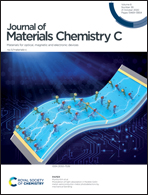Permittivity boosting in “yellow” (Nb + In) co-doped TiO2†
Abstract
Unusual effects of post annealing on optical and dielectric properties of (Nb0.5In0.5)0.01Ti0.99O2 (NITO-1.0%) are reported in the present study. The post-annealing performed under embedding in Al2O3 powder changes the color of a NITO-1.0% single crystal from black to yellow. Furthermore, the apparent increase in the relative permittivity due to the Maxwell–Wagner–Sillars effect, on the order of 104, observed in the as-synthesized NITO-1.0% completely disappears after the post-annealing to reveal an intrinsic enhancement of dielectric response due to the co-doping of Nb and In. The relative permittivity of the post-annealed NITO-1.0% uniformly increases by approximately 120 from the original value of pure-TiO2 over a wide temperature range from 4.2 K to room temperature. A temperature dependence of permittivity in the post-annealed NITO-1.0% shows behavior that is qualitatively identical to that of pure TiO2, indicating that the co-doping gives rise to an additional dielectric response in TiO2, probably through creation of defect complexes with large polarizability. The polarizability of the defect complex is estimated to be two hundred times greater than that of Ti4+, giving a new insight for the design of novel dielectric materials with large permittivity by means of complex defect engineering.



 Please wait while we load your content...
Please wait while we load your content...
